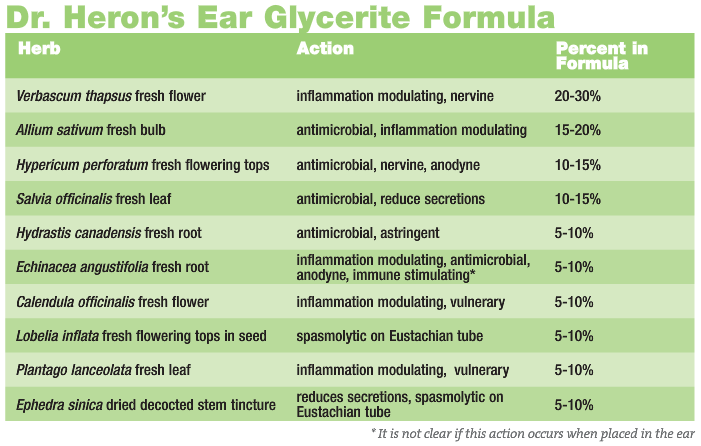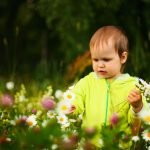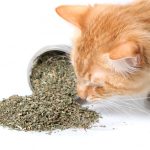Eric Yarnell, ND, RH(AHG)
Ear Glycerite vs. Ear Oil
A pediatric nurse practitioner (PNP), who prefers to remain anonymous, in Sedona, Arizona, began consulting with my late mentor, Silena Heron, ND, many years ago. The PNP had been practicing allopathically for many years, and was prescribing antibiotics for most of the children in her busy practice who had otitis media. Dr. Heron helped the PNP (along with other influential natural medicine practitioners) change her practice to be more holistic. These days, it is rare if the PNP has to prescribe antibiotics for otitis media patients more than once or twice a year.
Among the most critical of these changes was her adoption initially of an ear oil formula Dr. Heron had developed. However, the PNP quickly came to dislike this, as the darkness of the olive oil base for this product obscured the tympanic membrane. Also the oil was relatively difficult to clear off the membrane with a swab to make visualization easier. This made monitoring the progress of the otitis media very challenging.
So Dr. Heron developed an ear glycerite formula as an alternative. Because glycerite is clear and was much easier to swab off the membrane, it proved much easier to monitor progress. The PNP has never gone back to using ear oil. She continues to see at least 100 children a year with otitis media and has had wonderful results with the ear glycerite formula. The general idea is to relieve symptoms enough that parents don’t demand more aggressive therapy, and thus greatly reduce antibiotic prescribing. Furthermore, in those rare instances where ear glycerite does not fairly immediately relieve pain and get children to sleep, it can be an additional sign of a true bacterial infection. The PNP of course combines ear glycerite with internal immune-stimulating, inflammation-modulating, antiviral herbs as well as homeopathy, dietary advice, and other approaches to optimize recovery from otitis media. Dr. Heron taught me to make glycerites by macerating the fresh herbs in 75% glycerin for 2-4 weeks, and not to make a tincture then remove the alcohol, as she believed the additional processing in the latter method damaged the herbs, reducing their potency.
The ear glycerite should be warmed before use to prevent nystagmus (often by placing a dose into a teaspoon then warming it with a lighter, held away from the child until warm to avoid setting anyone on fire). It should be used for certain at bedtime and kept in place with a piece of cotton throughout the night if possible, and a second dose can also be used during the day just before a nap.
Though some practitioners say that putting glycerin in the ear will promote yeast growth, the PNP and Dr. Heron have never observed this in practice.

Catnip Glycerite
A glycerin extract of Nepeta cataria (catnip) leaf is a wonderful addition to any formula for children with upper respiratory tract infections (URI). Catnip is mildly antiviral, but its primary functions in the formula are as a corrigent to make it taste better and as a nervine to help the children sleep and thus recover more quickly. Generally around 10% added to a formula will give it an overall lemony taste and have a significant calming, nervine effect. This herb has been previously reviewed in greater depth by me in NDNR (September 2005, volume 1, issue 4).
Ephedra in Children
Though currently there is a wave of fear washing through the nation about Ephedra sinica (ma huang) stem, it is a very useful medicine in children when used properly. Its optimal indications are cranky, irritable children with postnasal drip or other allergy/post-URI symptoms that are keeping them from sleeping, or awakening them from sleep too often for them to really rest. As one could also glean from the information above, it also works fabulously when placed in the ear to help relax the Eustachian tubes in children with otitis media.
While ma huang is generally speaking a stimulant, proper dosing in the setting of a child who can’t sleep due to the symptoms described above will almost always lead to the child sleeping. This then allows the harried parent or guardian to get some rest as well. A typical dose would be 5-10 drops by mouth of a tincture made from the decocted stem (25%-30% ethanol), depending on the body size of the child. Adults can take up to 1 ml (20-25 gtt) for similar situations. It may be necessary to repeat the dose every 2-3 hours. I have never seen nor heard of adverse effects at this dose in children.
The PNP has also used ephedra in formulas for years to help temporarily alleviate URI and allergy symptoms in children so that other medicines have a chance to work on the underlying problems and get the kids well more quickly. She has also never seen it have stimulating or other negative effects at these doses, used for a few days to a couple of weeks at the most. Ma huang should be avoided in children with urethral strictures or hypertension, and should be combined with caution with stimulant drugs. Though ephedra is illegal to prescribe for weight loss throughout the United States it is legal to prescribe for other reasons, though there are many restrictions on a state-by-state basis (including some specifically relating to minors), so check with local regulations before proceeding.
Note: Dr. Yarnell is part owner of Heron Botanicals, the company started by Dr. Heron, which does sell the ear glycerite formula mentioned above. However, this combination could be formulated and obtained from other sources.
 Eric Yarnell, ND, RH(AHG), is a graduate of Bastyr University. He completed a 2-year residency with Silena Heron, ND, and served as chair of botanical medicine at the Southwest College of Naturopathic Medicine. He is past senior editor of the Journal of Naturopathic Medicine. Dr. Yarnell is a founding member and current president of the Botanical Medicine Academy and author of numerous textbooks and articles including Naturopathic Urology and Men’s Health, Naturopathic Gastroenterology, and Clinical Botanical Medicine. His area of clinical focus is urology and men’s health. He is assistant professor in botanical medicine at Bastyr University.
Eric Yarnell, ND, RH(AHG), is a graduate of Bastyr University. He completed a 2-year residency with Silena Heron, ND, and served as chair of botanical medicine at the Southwest College of Naturopathic Medicine. He is past senior editor of the Journal of Naturopathic Medicine. Dr. Yarnell is a founding member and current president of the Botanical Medicine Academy and author of numerous textbooks and articles including Naturopathic Urology and Men’s Health, Naturopathic Gastroenterology, and Clinical Botanical Medicine. His area of clinical focus is urology and men’s health. He is assistant professor in botanical medicine at Bastyr University.





